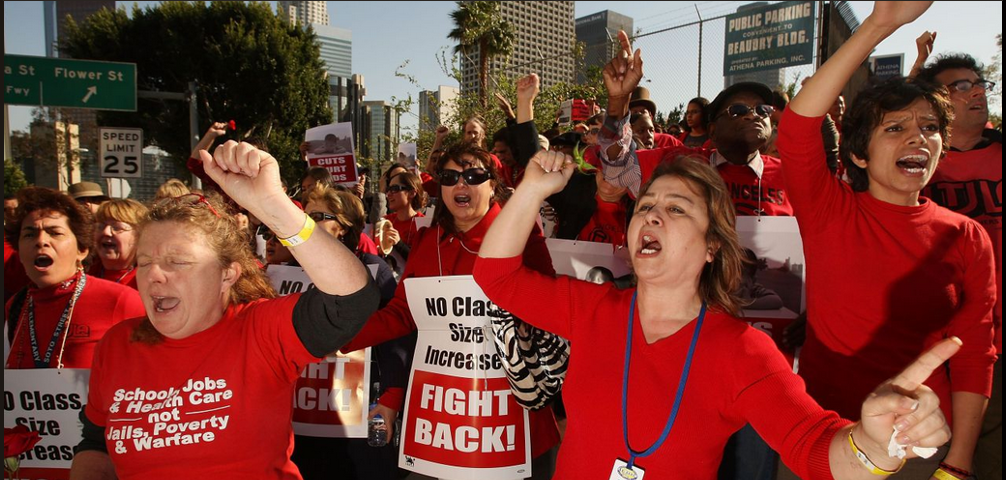Photo by David McNew / Getty Images
By Ann Montague, Published on Socialist Action, February 7, 2019
The new wave of teachers’ strikes suggests one way that the fight for women’s liberation from the privatized tasks of social reproduction may unfold. The recent one-week strike in Los Angeles, which featured demands to arrest the privatization of public education and improve student health services, reaffirms the potential of political strikes to socialize care work.
The wave of teachers’ walking off their jobs in 2018 got a lot of attention, but it all started the year before on International Women’s Day. The March 8 strikes were organized in the three months following the mass outpouring of four million women in marches across the country on Jan. 21, 2017. The enthusiasm from these marches and the launching of the International Women’s Strike U.S. resulted in the closing of school districts as teachers and staff walked out on International Women’s Day.
The first school districts that announced they were closing were in “right to work” states. Sixteen schools were closed in North Carolina and all the schools in Alexandria, Va. In addition, 33 teachers walked out of an elementary school in Philadelphia to protest working for four years without a contract, and 1700 teachers and transportation staff closed the school district in Prince George’s County, Md.
In 2018, the teachers’ strikes were no longer sporadic and by district but took place statewide. The strikes were organized and led by women. The question arises: What moved these women workers to organize major strikes, including political strikes?
While public sector unions have a strong strike tradition, in past decades they have been quiet. Public sector workers always have their eyes on the legislative budget process. In recent decades, their emphasis has been on elections. But in 2018 a massive and militant strike of women workers went to the state capitols not to lobby disinterested politicians but to make demands and dare them to jail the strikers. They then refused to return to work until they were ready and saw the deal in writing. Of course, ever increasing cuts to education funding are still taking place, but the cutbacks were held in check through last year’s strike action.
For the last few decades, the working class has been under assault. And for women this has been accompanied by extreme cuts to social services and pressure for women to “volunteer” to fill the gaps by working for free.
Teachers likewise are often compelled to fill the gaps in social services funding—for free. Additional work outside the classroom now includes programs to assist students who are homeless, addressing food insecurity, and dealing with cuts in positions for school nurses. In many schools they now serve both breakfast and lunch, and for homeless students they also pack additional food for the weekend.
Counselors, social workers, and teachers all work together to find better homeless shelters that are closer to the school and also deal with increased student anxiety. Teachers generally pick up clothes at garage sales for students.
The lack of parenting skills often lands on teachers who work with parents. Due to cuts in Children’s Services, they must deal with crisis situations, which leaves children suffering from basic neglect to receive assistance from teachers and counselors.
Although gender wage disparity has disappeared from most salary schedules, it is easier for male teachers to take additional classes to receive higher pay than it is for women teachers, because of their responsibilities in the home.
These extra responsibilities were a focus of the teachers’ strike vote on Aug. 31, 2018, in the Los Angeles School District—the second largest school district in the country. The strike vote was 98%-2%. The two primary issues were the contract language on teacher/student ratios, which are up to 46 students without a class assistant. The other issue was “restoring essential support structures that students need.” Examples they gave were nurses, social workers and counselors. One school currently has a half-time nurse for 2000 students. Social workers at schools never have enough time to work with students, so the work falls on teachers or counselors.
The increasing militancy of teachers will challenge state austerity budgets. The teachers have often advocated for all public workers in their strike demands. Next year, bargaining will start for state worker contracts, and we will see if they will join together with teachers on the picket line.
The current strike wave will continue, although we can expect that employers will start pushing back. In Washington State recently, they threatened to replace teachers unless they returned to class.
Community support will be needed to resist the increasing pressures on teachers. In most strikes, both students and parents have supported the teachers’ picket lines. The unions will also need to give support and solidarity in order to gain continued victories.
These strikes can set an example of how to fight against the deepening privatization of social reproduction and point to a future in which women can use proletarian methods to fight their oppression overall.
Excerpted from Socialist Action’s forthcoming “Women’s Liberation Resolution.”
